Overview
Building a successful B2B commerce website might seem daunting, but it can be broken down into six essential steps.
- First, let’s get to grips with the fundamentals of B2B. Think about it—what makes B2B different from B2C? Understanding this is crucial.
- Next, identify the key features your website needs. What do your users really want?
- Choosing the right technology is the next big step. This is where things can get a bit technical, but don’t worry! It’s all about finding the tools that work best for your business.
- After that, integrating with your existing systems is vital. You want everything to work seamlessly, right?
- Now, let’s talk about user experience. Designing your site with your users in mind is key to keeping them engaged. Ask yourself: is it easy to navigate?
- Finally, testing for performance can’t be overlooked. How will you know if it’s working if you don’t check?
Each of these steps highlights how important it is to tailor your website to meet the unique needs of B2B buyers. Think about facilitating complex transactions and enhancing user engagement. By doing this, you’re not just building a website; you’re driving growth and ensuring customer satisfaction. So, are you ready to take your B2B website to the next level?
Introduction
Building a successful B2B commerce website isn’t just about slapping together a few pages and calling it a day. It requires a nuanced understanding of the unique dynamics that govern business-to-business transactions. With buyer needs becoming more complex and the demand for a seamless purchasing experience on the rise, companies really need to think strategically about how they design their online platforms. After all, it’s all about fostering engagement and making transactions as smooth as possible.
But here’s the kicker: many businesses face hurdles when it comes to integrating essential features and optimizing their sites for performance. So, how can organizations tackle these challenges? How can they create a robust B2B commerce website that not only meets customer expectations but also drives growth? Let’s dive into this together and explore some actionable insights!
Understand B2B Commerce Fundamentals
B2B commerce, or business-to-business commerce, is all about transactions between companies, which is quite different from what you see with individual consumers. So, why is it important to understand its key characteristics? Well, doing so can really help you optimize your online presence!
- Complex Sales Processes: Ever noticed how B2B transactions often involve multiple stakeholders? This can lead to longer decision-making cycles. That’s why having a B2B commerce website that facilitates clear communication and provides all the necessary information is crucial. According to Forrester, 75% of B2B buyers found their latest purchase to be difficult. Streamlining these processes can make a world of difference!
- Bulk Orders: Businesses usually buy in larger quantities, which means you need tailored pricing strategies and solid inventory management. Adding features that cater to bulk ordering can really enhance the purchasing experience and boost sales. A case study from TradeCentric even shows that suppliers who invest in B2B Connected Commerce can expect increased revenue and higher order volumes. Who wouldn’t want that?
- Customized Solutions: B2B buyers are often looking for solutions that fit their specific needs. By offering flexible product options, including customizable choices, you can significantly boost client satisfaction and loyalty. As John Bruno, VP of Strategy at PROS, puts it, "B2B companies can meet this demand for greater personalization by using real-time integrated data to build personalized buyer journeys." Sounds like a win-win, right?
- Relationship Management: Building strong connections with clients is key for repeat transactions. Your website should have tools for , like personalized communication and support channels, to nurture those long-term partnerships. Research shows that simplifying the purchasing process can lead to deeper loyalty among B2B buyers.
By grasping these essentials and keeping an eye on industry trends, you can create a B2B commerce website that effectively addresses the unique needs of B2B clients. This not only improves their purchasing experience but also fosters growth. So, are you ready to take your B2B commerce to the next level?
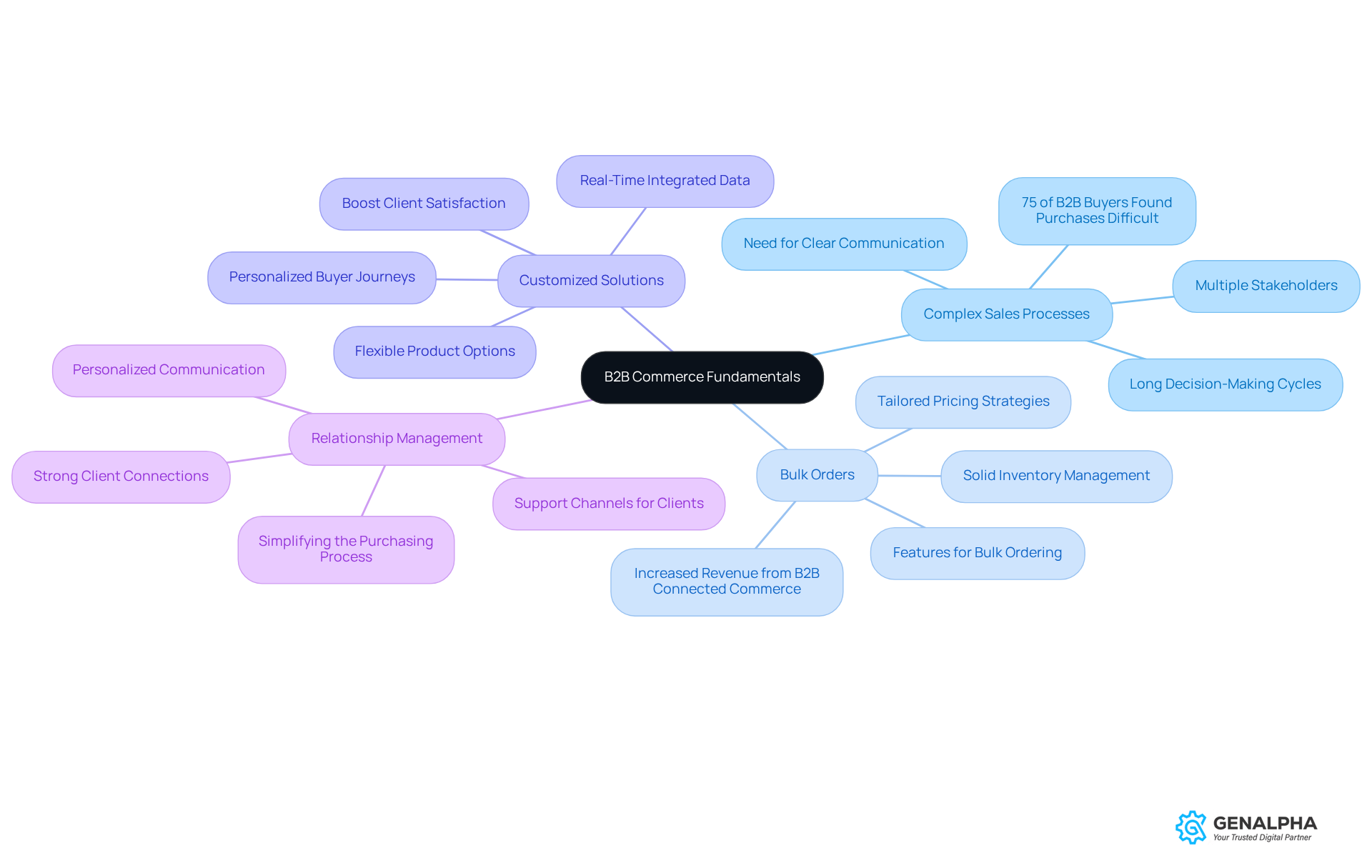
Identify Key Features and Requirements
When you're building a b2b commerce website, there are several that can significantly optimize user experience and operational efficiency. Let’s dive into them!
- User Accounts: Imagine being able to create multiple user accounts under one company profile. This streamlines order management and permissions, allowing different team members to access tailored functionalities. It’s all about enhancing collaboration and efficiency! Did you know that 60% of B2B clients find purchasing products online more convenient than traditional channels? That’s according to McKinsey & Company, highlighting just how crucial user-friendly account management is.
- Bulk Ordering: Now, let’s talk about bulk ordering. Implementing features that facilitate bulk orders is vital for B2B transactions. Quick order forms and saved order templates mean clients can place large orders in no time. This not only saves time but also reduces the likelihood of errors. Just look at Grainger Industrial Supply—they’ve optimized their mobile site to enhance the bulk ordering experience!
- Custom Pricing: Next up is custom pricing. Providing tailored pricing based on client segments or order history can really set you apart. This approach ensures that businesses meet the unique financial needs of their clients, fostering loyalty and repeat purchases. Industry experts agree—transparency in pricing is critical to staying competitive in the B2B market.
- Inventory Management: Integrating real-time inventory tracking is another essential feature. It offers individuals precise product availability information, helping to prevent order delays and fostering trust. Siemens does a great job with seamless navigation on its B2B commerce website, making inventory visibility easy for buyers.
- Payment Options: Let’s not forget about payment options. Offering various payment methods, including credit terms, caters to the diverse financial needs of B2B clients. Flexible payment solutions can really enhance customer satisfaction and streamline the purchasing process. For instance, IndiaMART provides a range of payment methods, from credit cards to mobile wallets, making transactions a breeze.
- Analytics and Reporting: Finally, incorporating tools for analyzing purchasing patterns can help organizations enhance their procurement strategies. By leveraging data insights, companies can make informed decisions that drive efficiency and cost savings. It’s proven that implementing analytics tools can enhance operational efficiencies, ultimately boosting profits.
These features together create a robust b2b commerce website that not only meets the needs of modern buyers but also positions companies for continued growth in a competitive marketplace. What features do you think would make the biggest difference for your business?
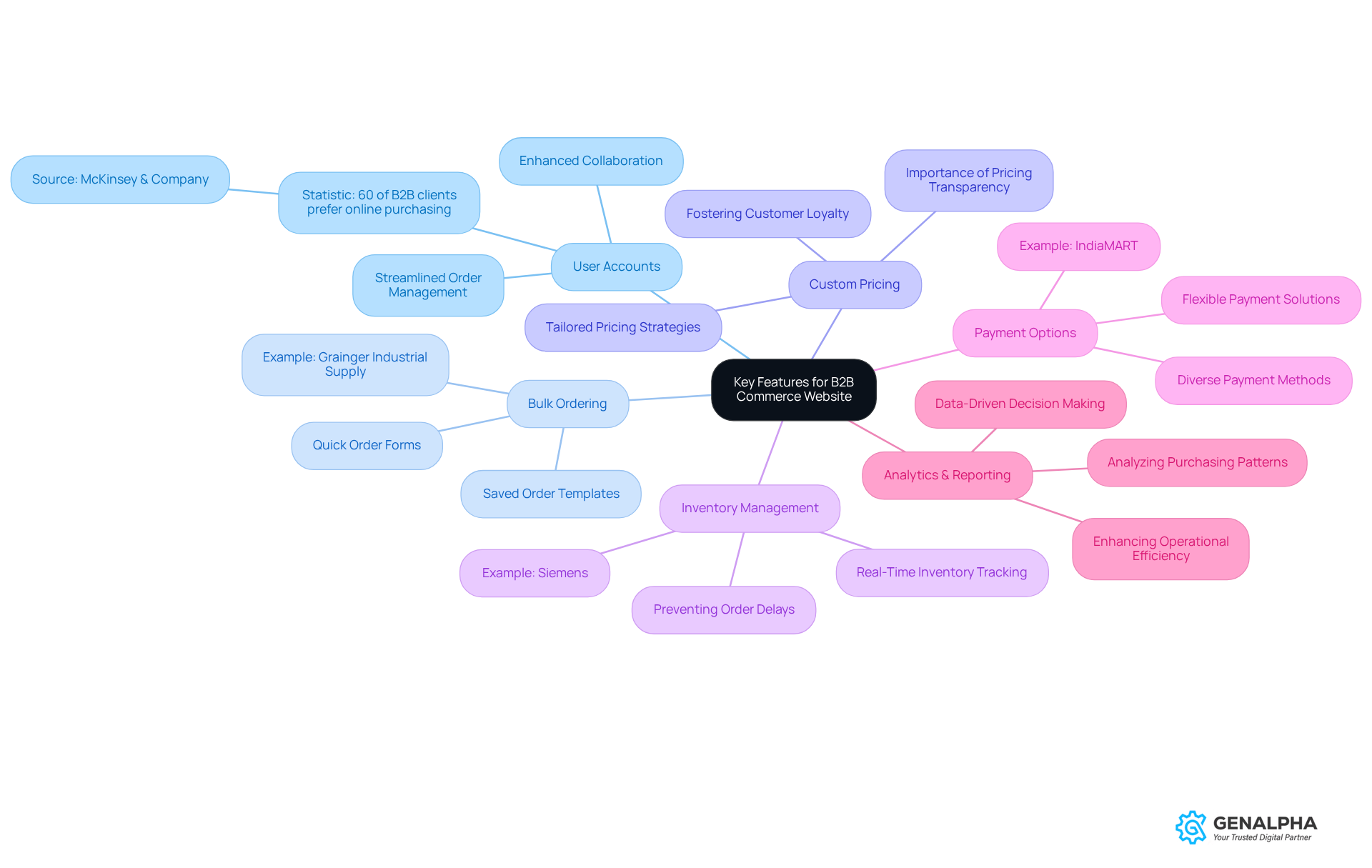
Choose the Right Technology and Platform
Choosing the right technology and platform can feel overwhelming, but it doesn't have to be! Let's break it down together:
- SaaS vs. On-Premise: First off, think about whether a Software as a Service (SaaS) solution or an on-premise system fits your business needs better. SaaS is great for flexibility and usually comes with lower upfront costs. On the flip side, on-premise solutions give you more control over your systems.
- Scalability: Next, consider scalability. You want a that can grow with your business, managing increased traffic and transactions as your client base expands.
- Integration Capabilities: Don’t forget about integration! Look for platforms that can easily mesh with your existing systems, like ERP and CRM, to keep everything running smoothly.
- Customer Experience: What about your customers? Choose a platform that prioritizes their experience, offering intuitive navigation and responsive design to keep them engaged.
- Security Features: Lastly, security is key. Make sure the platform meets industry standards for data protection and has strong security measures in place to protect sensitive information.
By taking these factors into account, you'll be well on your way to selecting the perfect technology solution for your needs!
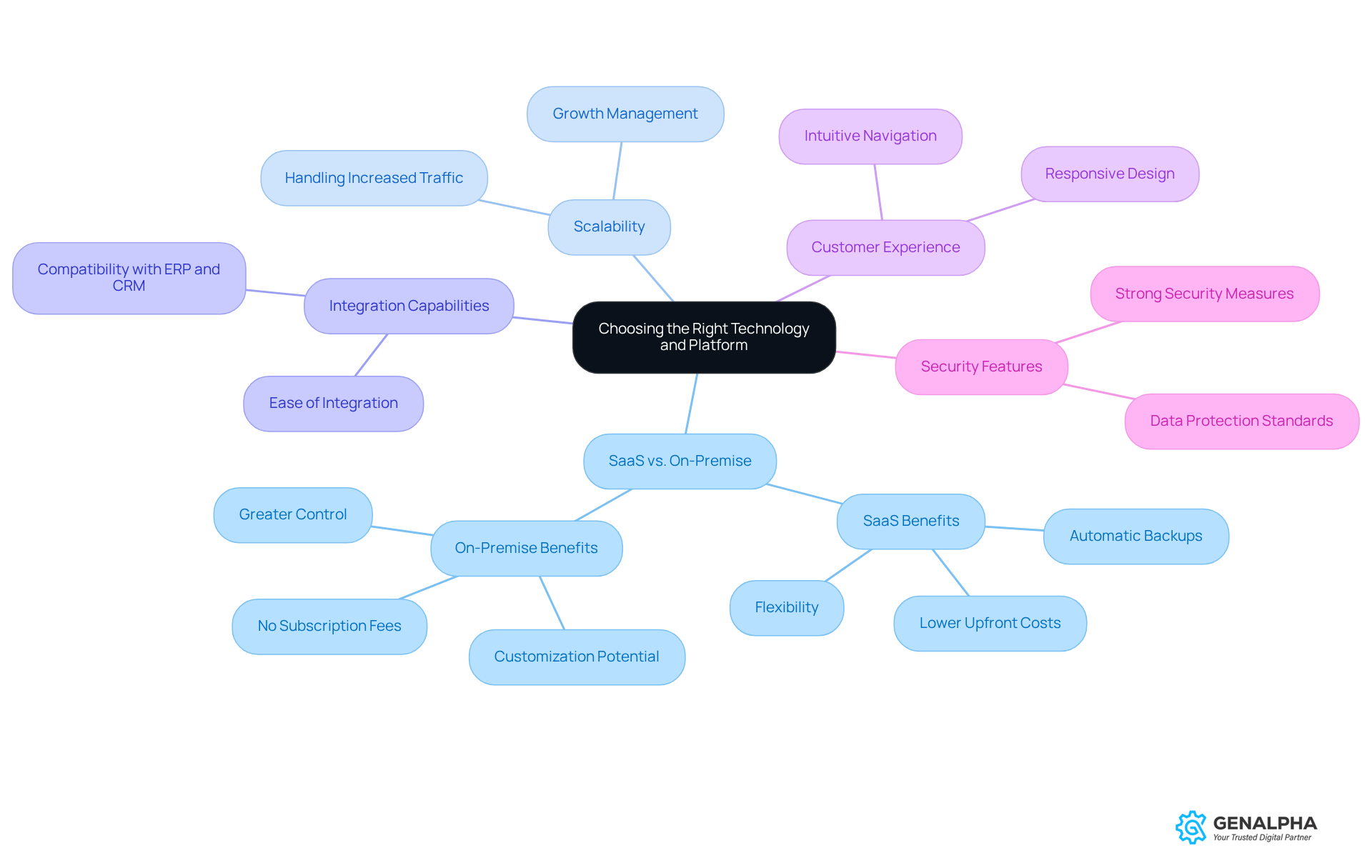
Integrate with Existing Systems
If you're looking to seamlessly integrate your B2B website with your existing systems, here’s a friendly guide to get you started:
- Assess Current Systems: Let’s kick things off by taking a good look at your current ERP, CRM, and other software. What are their strengths? What could use a little work? Understanding these capabilities is key to a successful integration.
- Choose Integration Methods: Next up, think about how you want to integrate. Will you go for API integrations, middleware solutions, or maybe some custom development? Pick the method that fits your technical resources and operational needs best. And don’t forget—real-time data access and synchronization are crucial for keeping up with demand fluctuations and any operational hiccups.
- Data Mapping: Now, let’s talk about data mapping. You’ll want to align the data fields in your existing systems with those in your B2B commerce website. This step is vital for smooth data transfer and reducing discrepancies. Remember, accurate data syndication is important; poor mapping can lead to some serious operational risks.
- Testing: Before you go live, it’s time for some thorough testing of your integration process. This is your chance to uncover any potential issues. Plus, you’ll need a solid data migration plan that includes cleansing and validation tools to ensure everything transfers accurately. This step is essential for keeping your operations running smoothly.
- Training: Don’t forget about your team! Make sure they get the training they need to navigate and use the integrated systems effectively. Understanding how everything works will help and minimize disruptions during the transition.
- Monitor and Optimize: Once everything is integrated, keep an eye on system performance and gather feedback from your team. This will help you spot areas that could use a little tweaking. Regular optimization is key to ensuring your integration stays effective and adapts to any changes in your business needs or market demands.
So, are you ready to take your B2B website integration to the next level?
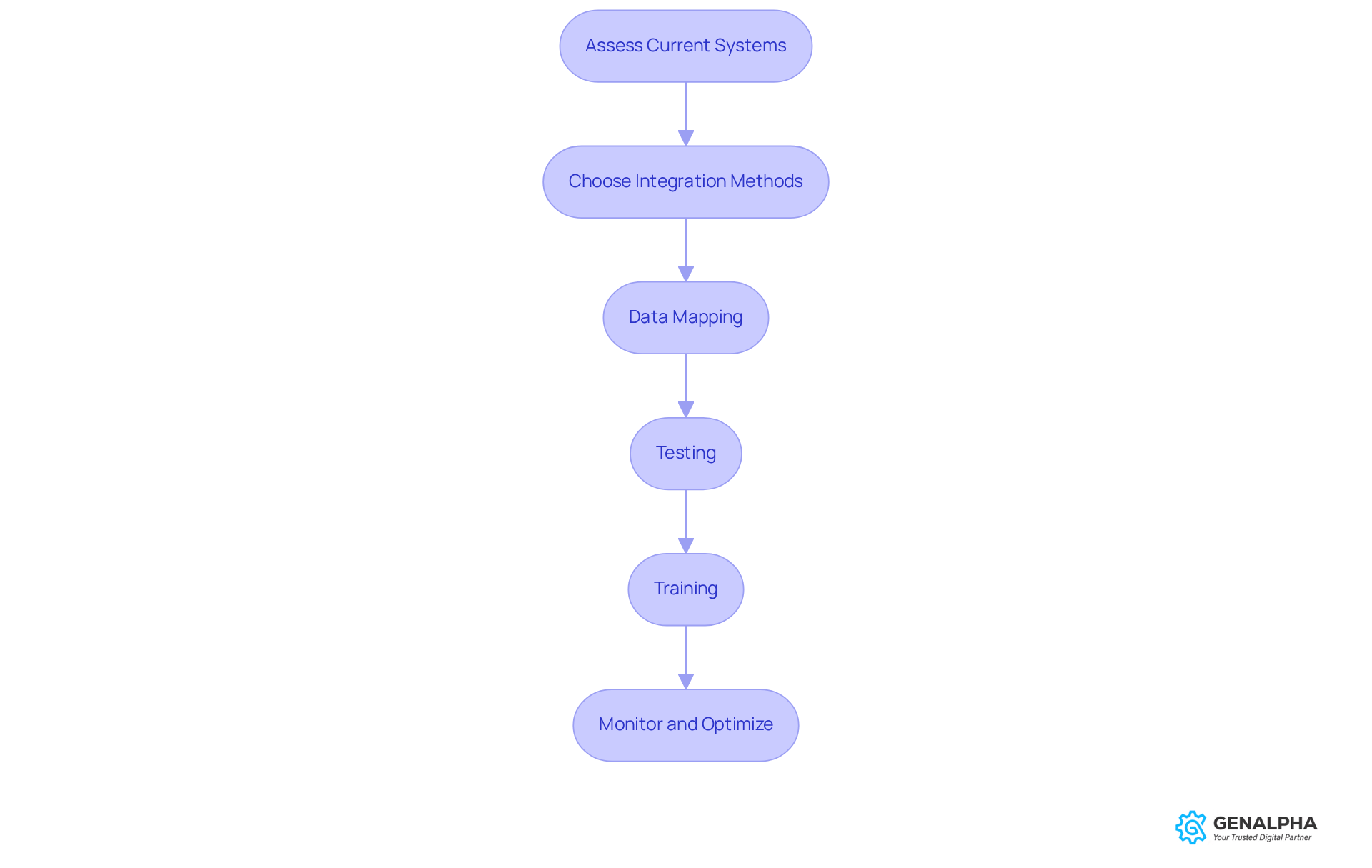
Design for User Experience and Engagement
Creating a user-friendly B2B website? Let’s dive into some design principles that can make a big difference:
- Intuitive Navigation: Think about how frustrating it can be to get lost on a website. A clear and logical navigation structure helps users find exactly what they need without the hassle. This is especially important in B2B, where often involve multiple stakeholders and lengthy sales cycles.
- Responsive Design: We live in a multi-device world, right? Optimizing your website for desktops, tablets, and smartphones ensures a seamless experience for everyone. Research shows that responsive design can boost conversion rates because mobile visitors appreciate sites that load quickly and look great. Plus, a well-executed design enhances your credibility and makes your site accessible to all potential visitors.
- Visual Hierarchy: Ever landed on a site and immediately knew where to look? That’s the magic of visual hierarchy. Use design elements to guide attention towards key information, like calls to action and product details. A polished, modern appearance not only looks good but also reassures clients of your company’s legitimacy and expertise—crucial in the B2B landscape.
- Content Quality: High-quality, relevant content is a must. It should address your audience’s needs and pain points. Engaging content doesn’t just attract visitors; it builds trust and positions your brand as an industry authority. Who wouldn’t want that?
- Engagement Features: Think about incorporating features like live chat, client reviews, and personalized suggestions. These elements can significantly enhance the customer experience. In fact, 80% of high-performing B2B organizations say their customer experience strategies boost customer lifetime value.
By focusing on these principles, you can create a B2B commerce website that not only meets visitor expectations but also drives conversions and fosters long-term relationships. Ready to get started?
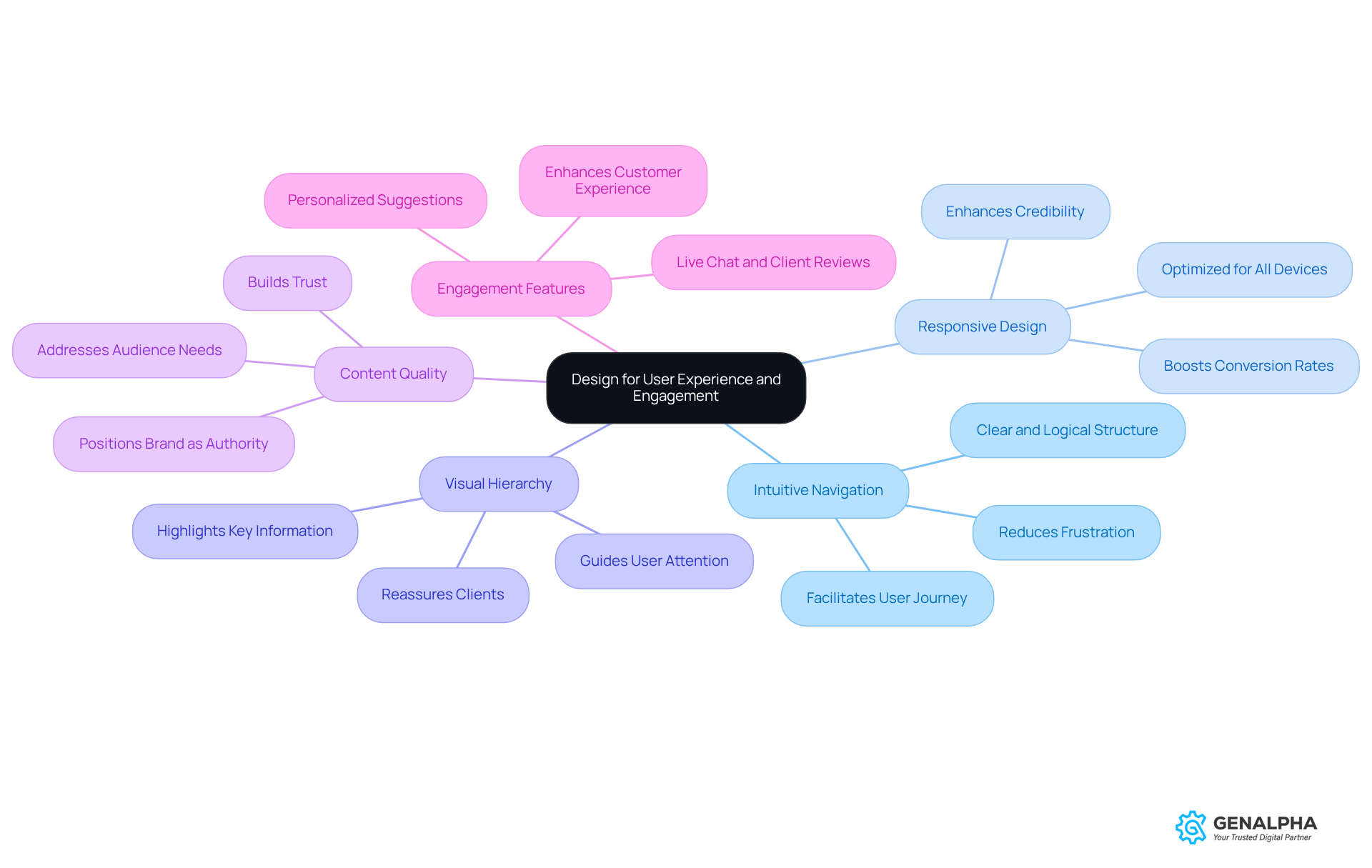
Test and Optimize for Performance
To make sure your B2B website is performing at its best, let’s dive into some testing and optimization strategies that can really make a difference:
- A/B Testing: How often do you experiment with your website? Regularly conducting A/B tests on key elements like headlines, CTAs, and layouts can lead to impressive improvements in audience engagement and conversion rates. In fact, studies show that A/B testing can boost conversions by over 1500%! Companies like Dell have even reported a whopping 300% increase in their conversion rates thanks to smart A/B testing strategies. As Pratyusha Guha puts it, "Why gamble with your resources when you can make informed data-driven decisions?"
- Performance Monitoring: Are you keeping an eye on how your website is doing? Utilizing is crucial for tracking website speed, uptime, and visitor behavior. Tools like New Relic and Adobe Commerce's Site-Wide Analysis Tool can provide valuable insights into essential performance metrics, including the Apdex score, which measures application performance based on user experience. Did you know that around 71% of companies run two or more tests each month? This highlights just how important ongoing performance evaluation is!
- Participant Feedback: How well do you know your customers? Actively collecting feedback from participants is a fantastic way to understand their experiences. Grasping customer sentiment is key to identifying areas that need improvement, ultimately boosting client satisfaction and loyalty.
- Continuous Improvement: Are you ready to embrace a cycle of testing, analyzing, and optimizing? This iterative approach allows you to continually enhance your website's performance and visitor experience. By adapting to changing market conditions and user preferences, you can foster a culture of experimentation that leads to significant revenue increases. For instance, Booking.com has successfully built a culture of testing, resulting in remarkable improvements in their conversion rates.
By integrating these strategies, B2B companies can build a strong online presence that not only meets but exceeds customer expectations. So, are you ready to take your website to the next level?
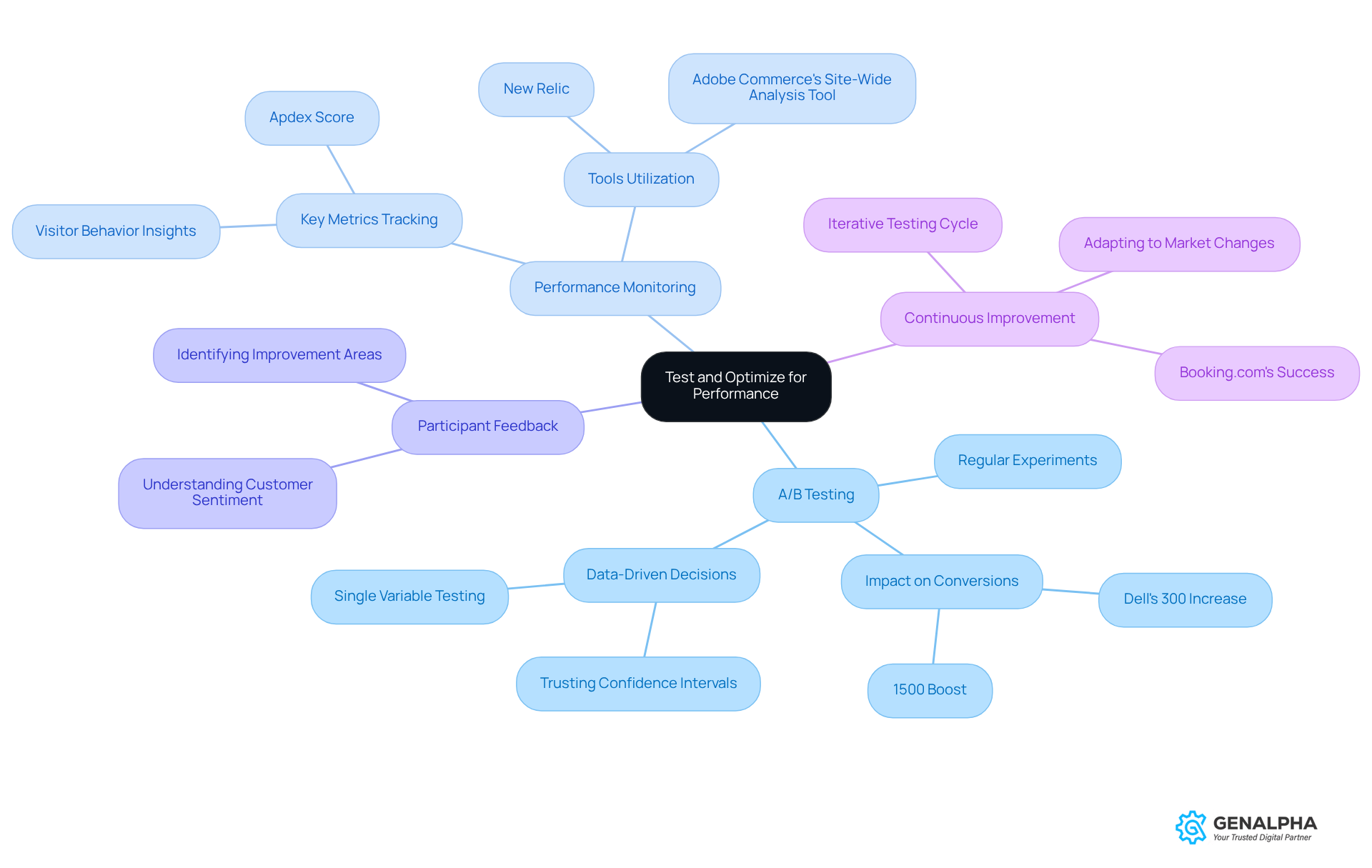
Conclusion
Creating a successful B2B commerce website isn’t just about slapping some products online; it’s about truly understanding the unique nature of business-to-business transactions. Think about it: by diving into the complexities of sales processes, bulk ordering, customized solutions, and effective relationship management, businesses can craft an online space that not only meets but exceeds what B2B clients expect. Tailoring your website to these specific needs is crucial—it’s the bedrock for boosting customer satisfaction and building lasting partnerships.
Key features like:
- User accounts
- Bulk ordering options
- Custom pricing
- Real-time inventory management
- Diverse payment methods
- Robust analytics tools
are vital for optimizing user experience and operational efficiency. Plus, choosing the right technology platform and ensuring it integrates seamlessly with your existing systems can really amp up functionality and security. Let’s not forget the user experience: intuitive design, responsive layouts, and engaging content are essential for capturing and keeping clients.
Ultimately, building a successful B2B commerce website is a journey—a continuous cycle of testing, optimizing, and adapting. By fostering a culture of continuous improvement and harnessing data-driven insights, businesses can not only keep up with market demands but also set themselves apart as leaders in the competitive B2B landscape. So, are you ready to take these steps? Elevating your user experience will undoubtedly drive significant growth and success in the ever-evolving world of B2B transactions.
Frequently Asked Questions
What is B2B commerce?
B2B commerce, or business-to-business commerce, refers to transactions that occur between companies, differing significantly from transactions with individual consumers.
Why is understanding B2B commerce important?
Understanding B2B commerce helps optimize online presence and improves the purchasing experience for clients by addressing their unique needs.
What are the characteristics of B2B sales processes?
B2B sales processes often involve multiple stakeholders, leading to longer decision-making cycles. Clear communication and comprehensive information on B2B commerce websites are crucial to streamline these processes.
How do bulk orders impact B2B commerce?
Businesses typically purchase in larger quantities, necessitating tailored pricing strategies and effective inventory management. Features that facilitate bulk ordering can enhance the purchasing experience and increase sales.
What role do customized solutions play in B2B commerce?
B2B buyers often seek solutions that fit their specific needs. Offering flexible product options and customizable choices can significantly enhance client satisfaction and loyalty.
How important is relationship management in B2B commerce?
Building strong connections with clients is essential for repeat transactions. Effective relationship management tools on websites, such as personalized communication and support channels, can nurture long-term partnerships.
What are key features to include when building a B2B commerce website?
Key features include user accounts, bulk ordering capabilities, custom pricing, real-time inventory management, diverse payment options, and analytics and reporting tools.
How do user accounts enhance B2B commerce?
User accounts allow multiple users under one company profile, streamlining order management and enhancing collaboration, which is essential for efficiency.
Why is custom pricing important in B2B transactions?
Custom pricing based on client segments or order history helps meet the unique financial needs of clients, fostering loyalty and encouraging repeat purchases.
How does real-time inventory management benefit B2B clients?
Real-time inventory tracking provides accurate product availability information, helping prevent order delays and building trust with buyers.
What payment options should be offered in B2B commerce?
Offering various payment methods, including credit terms, accommodates the diverse financial needs of B2B clients and enhances customer satisfaction.
How can analytics and reporting tools improve B2B operations?
Analytics tools help organizations analyze purchasing patterns, enabling informed decision-making that enhances efficiency and drives cost savings.




